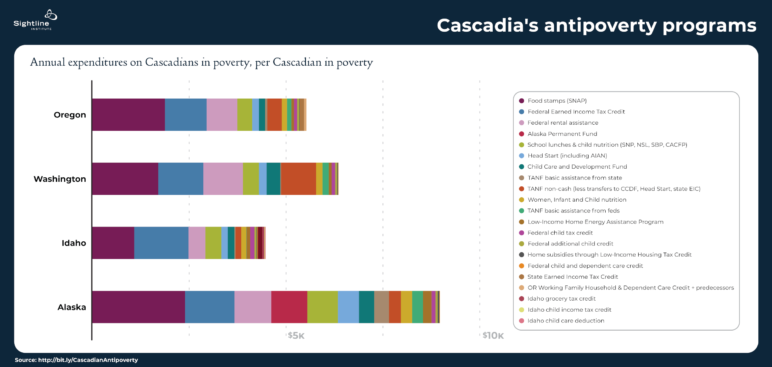Like a tree twisted by a shadow above it, everything about anti-poverty policy in the United States has been shaped by one unusual decision: not to give poor people cash.
Want housing, but can’t afford it? Join a voucher waitlist. (Oh, and also sign up separately to 17 other waitlists for particular buildings or organizations.) Launched a small business and need to eat while it grows? Sorry, your state might require you to spend down your savings and sell your car before you can get food stamps. Need child care so you can get a job? Well, we subsidize that through a federal tax deduction, but only if you decide not to claim a different federal tax deduction. (Tough luck if, like the families of more than half of US kids in deep poverty, you don’t file taxes. You really should find more time in your schedule for paperwork, so you can give the government information it already has. It builds character.)
The impulse to micromanage the household budgets of the poor gradually created a vast array of valuable but convoluted social programs, separately applied for and maintained at incalculable burden to their recipients.

Bars represent annual state and federal spending on each universal cash program per resident of each state, plus annual state and federal spending on each means-tested welfare program per person living beneath the poverty line in each state. See this article for more details. Data, from many sources, is here, along with an interactive version of this and other charts. Click here for a larger version.
The American Rescue Plan signed last week opens the door to an alternative approach to future expansions of the US social safety net: giving people money and letting them decide how to use it.
Among many other things, the new economic stimulus bill overhauls the existing Child Tax Credit, an annual payment that previously maxed out at $2,000 per child per year for middle-income parents and gave the poorest families nothing.
Instead, the Rescue Plan creates a cash payment of $3,000 per child aged six to 17 and $3,600 per child under five years old. In many cases, this credit would be distributed as a monthly check.
And, crucially, the full sum would go even to kids in the poorest families. (That is, as long as their families have Social Security numbers and file taxes—more on that in a moment.) This means that, unlike the old Child Tax Credit, it’s a powerful antipoverty measure. Families that most need to prioritize housing in the right location could spend it on housing. Those that most need a bus pass, child care, or medicine could spend it on that.
Compared to other rich countries, this would bring US children to the middle of the pack in cash benefits—a smaller universal child benefit than in Canada or Germany, a larger one than in Norway or the Netherlands.
As I argued last month, a federal child payment is like a universal housing voucher for kids. Except it’s even better, because it’s cash.
Congress could make this program permanent, and better
There are several catches.
The biggest is probably that the plan signed last week by President Joe Biden will last for just one year. To make something like it permanent, Congress would need to find an ongoing funding plan.
Fortunately, Congress has many options to fund the child credit permanently. Retiring the previous, regressive version of the Child Tax Credit would be a big start. The State and Local Tax deduction and Mortgage Interest Deduction are even more regressive, and now claimed by relatively few taxpayers. We could end them. There are also good, old-fashioned progressive income taxes. Or you could even pay for this with—are we supposed to whisper this these days?—a tax on carbon pollution.
Another catch: the Child Tax Credit doesn’t go to children without documented Social Security numbers, including immigrants, recent adoptees, and others. That’s despite empirical evidence that cash payments to children in poverty pay for themselves in economic benefits over a child’s life. Racial and xenophobic prejudices conceal the fact that humanity is a universal condition; universal programs reveal the things we share, including caring for children.
And here’s one more catch: you can’t get the Child Tax Credit if you don’t file annual tax forms, and many of the children who most need help live in families that didn’t file taxes in the previous year. There’s a strong case for giving this job to the federal government’s check-distribution experts, the Social Security Administration, rather than duct-taping it onto the duties of the tax collectors at the IRS.
Please consider signing our letter to Congress
However this debate moves forward, creating a permanent child payment will require advocates. That’s why my boss, Sightline Executive Director Alan Durning, joined a number of peers last week to co-sign a letter to Oregon’s delegation in Congress. Joining him were Kim McCarty of the Community Alliance of Tenants, Multnomah County Commissioner Jessica Vega Pederson, Ashley Henry of Business for a Better Portland, and Sarah Iannarone of The Street Trust. (Update 4/19: in Oregon, the letter has also since been signed by the Oregon Education Association, Our Children Oregon and Oregon Center for Public Policy.)
All came with slightly different perspectives and priorities, but all agreed that Congress could improve the lives of Oregonians by using progressive tax policy to permanently fund a simple, universal child payment. Every American would receive it during their childhood.
At full uptake, a per-child monthly payment of $250 (for example) would send:
- $270 million annually to the households of at least 90,000 children living in poverty in Oregon
- $419 million annually to the households of at least 140,000 children living in poverty in Washington
- $60 million annually to the households of at least 20,000 children living in poverty in Alaska
Of course, much of this money would come from households in Oregon, Washington, and Alaska that happen to have higher incomes. And that’s the whole point. Progressive taxation is the way to make a universal benefit progressive.
That’s why my Sightline colleagues in Washington and Alaska have been gathering allies for similar letters to congressional delegations in those states. So far, it’s been signed by Fuse Washington, Economic Opportunity Institute, Chief Seattle Club, the Washington Low-Income Housing Alliance, Children’s Alliance, MomsRising and the Washington State Budget and Policy Center.
If you or your organization would like to join us, you can now do that here.
As we write in the letter, a permanent, universal child payment would be a cornerstone of a healthy, just society here in Cascadia and across the United States. Let’s not miss this chance.











Marsha Hanchrow
Wait – you say I can sign as an individual, but the form demands an organization’s name. Do you want citizen endorsements?
Anna
Hi, Marsha, please sign on and skip the organization name. Thank you!
John
How about the parents doing what my parents did to reduce poverty. They both had jobs
Michael Andersen
Having a job is in fact a much more effective way to reduce poverty! Also (unlike anti-poverty cash payments before the 1996 welfare reform) it’s possible to receive this cash payment while also having a job. That’s one of the big upsides of a universal program.
That said, obviously some parents’ jobs don’t pay enough per hour to cover an hour of child care for a kid under 3. So for those folks TO get a job, they either need to lean on friends or family they trust (which they may or may not have) or they need some sort of assistance like this.